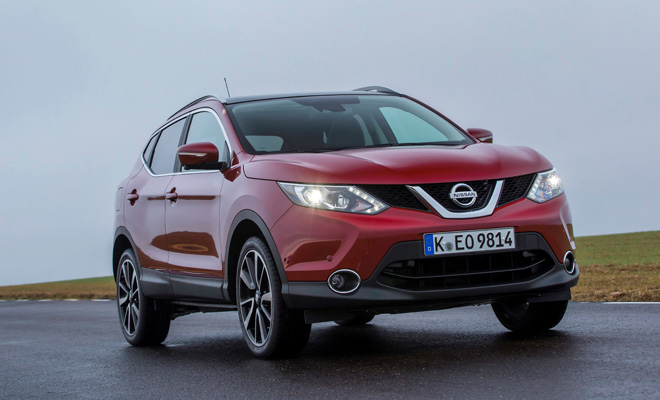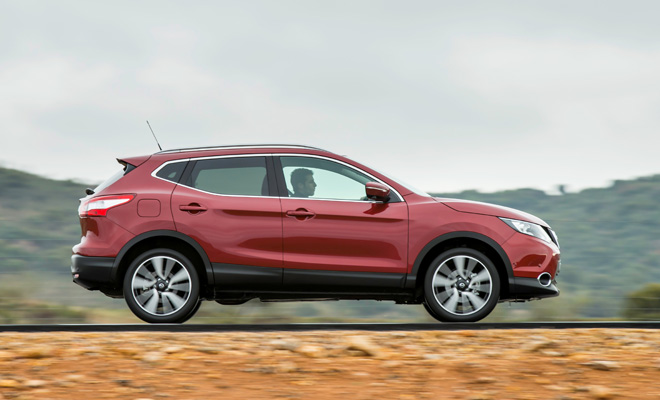by Antony Ingram 
In reality, it’s the easiest job in the world. I don’t mean to belittle the efforts of those who’ve spent many years and hundreds of thousands of man-hours developing the 2014 Nissan Qashqai, but really, given the previous Qashqai’s success, Nissan had to do little more than avoid messing it all up.

Nissan has succeeded. Not that the new generation is any more involving to drive than the original Qashqai, despite the funky new styling, so if you’ve clicked on this review expecting Nissan to have infused its family crossover with a little GT-R or 370Z, you’ll reach the end of this page disappointed. But in every other area the Qashqai isn’t just adept, but truly excellent at what it does.
The new, bigger Qashqai no longer has a seven-seat option, passing that baton to the all-new X-Trail. Instead, the extra space has liberated further room for passengers and luggage. The cabin is also exceedingly comfortable. There’s plenty of adjustment in wheel and seat, but its main trump card is refinement – very little wind, tyre or engine noise filters through to the interior. It’s well-built and high quality too, even if the dashboard design itself is a little bland. Ergonomics? Can’t be faulted, and visibility is also good.

For many buyers, though, the main attraction will be the car’s reduced CO2, and the resulting drop in taxation. The base diesel engine, a Renault-Nissan 1.5 dCi unit, develops 110PS and returns combined economy of 74mpg – enough for a tax-busting 99g/km of CO2. More impressively, the trip computer registered 67mpg after a gentle, but not deliberately economical drive on the Spanish roads of my test route.
A 1.6 diesel is also available, with 20 extra horses to its name and economy of 64mpg in manual, front-wheel drive form. Choosing the X-Tronic CVT automatic gearbox drops that to 61mpg, and in four-wheel drive, manual trim (there’s no four-wheel drive auto) you get 57mpg and 129g/km. Two petrol engines complete the range – 1.2 and 1.6-litre turbocharged units with 115 and 150PS respectively. Each returns an identical 50mpg, though the 1.2 just edges 1.6 on CO2, at 129g/km versus 132.

Both diesels are very refined for their type but the 1.2 petrol is the real star. It’s as good as inaudible at idle and only really makes its presence felt if you’re racing through the gears. It’s also surprisingly strong for such a small unit, rarely feeling breathless even with two people and their luggage on board.
Oddly, the smaller diesel felt more potent than the 1.6 dCi on the move, partly due to its snappy manual transmission. The X-Tronic CVT has been reworked by Nissan for a more natural, torque-converter feel, but despite praise from some quarters I found it lacking the benefits of either CVT or traditional auto – not as smooth as the former, nor as responsive as the latter. Diesel-wise, stick to the 1.5 manual and enjoy the greater economy.

The new Qashqai rides smoothly regardless of trim level, yet it’s an able turn-taker too. There isn’t the response and fleet-footed feel you’d find in a regular hatchback but among crossovers it’s as capable as any. I’d welcome a little more feel from the steering and perhaps a quicker rack too, but neither is vital and each might spoil the Qashqai’s unflappable motorway manners.
Prices start at £17,595 for a 1.2 petrol-powered car in basement Visia guise, while the top-level Tekna trim kicks off at £23,145. Nissan was keen to point out that Qashqais are 2 to 5 percent cheaper than equivalent VW Golfs, yet offer 2 to 6 percent more value.

The cars certainly seem stuffed with kit, while options like the Safety Shield pack (fitted as standard with the Acenta Premium or Tekna trim) even reduce insurance groupings, thanks to auto-braking, blind-spot detection, lane-keeping and around-view monitor capabilities. It can feel reassuring to have all this help on hand when ferrying your family about, and mercifully you do have the option to mute some of the more incessant warning beeps.
The new Qashqai then: economical, comfortable, spacious, inexpensive to run, cheaper than a Golf to buy and loaded with equipment designed to protect you and yours. If you have a family, and you need a car to carry them around in, this should feature on your shopping list. Very near the top.

Nissan Qashqai
Rating: stars
Good: Economy, refinement, copious kit
Bad: Bland interior, uninvolving drive
Price: from £17,595
You might assume that replacing the existing Qashqai would be a difficult task. How do you follow up a car that sold two million units over its six-year run? A car that hasn’t simply broken into the UK’s top-ten selling cars, but did so in the final three years of its lifecycle – rather than steadily fading away, as most cars do?Rating: stars
Good: Economy, refinement, copious kit
Bad: Bland interior, uninvolving drive
Price: from £17,595
In reality, it’s the easiest job in the world. I don’t mean to belittle the efforts of those who’ve spent many years and hundreds of thousands of man-hours developing the 2014 Nissan Qashqai, but really, given the previous Qashqai’s success, Nissan had to do little more than avoid messing it all up.

Nissan has succeeded. Not that the new generation is any more involving to drive than the original Qashqai, despite the funky new styling, so if you’ve clicked on this review expecting Nissan to have infused its family crossover with a little GT-R or 370Z, you’ll reach the end of this page disappointed. But in every other area the Qashqai isn’t just adept, but truly excellent at what it does.
The new, bigger Qashqai no longer has a seven-seat option, passing that baton to the all-new X-Trail. Instead, the extra space has liberated further room for passengers and luggage. The cabin is also exceedingly comfortable. There’s plenty of adjustment in wheel and seat, but its main trump card is refinement – very little wind, tyre or engine noise filters through to the interior. It’s well-built and high quality too, even if the dashboard design itself is a little bland. Ergonomics? Can’t be faulted, and visibility is also good.

For many buyers, though, the main attraction will be the car’s reduced CO2, and the resulting drop in taxation. The base diesel engine, a Renault-Nissan 1.5 dCi unit, develops 110PS and returns combined economy of 74mpg – enough for a tax-busting 99g/km of CO2. More impressively, the trip computer registered 67mpg after a gentle, but not deliberately economical drive on the Spanish roads of my test route.
A 1.6 diesel is also available, with 20 extra horses to its name and economy of 64mpg in manual, front-wheel drive form. Choosing the X-Tronic CVT automatic gearbox drops that to 61mpg, and in four-wheel drive, manual trim (there’s no four-wheel drive auto) you get 57mpg and 129g/km. Two petrol engines complete the range – 1.2 and 1.6-litre turbocharged units with 115 and 150PS respectively. Each returns an identical 50mpg, though the 1.2 just edges 1.6 on CO2, at 129g/km versus 132.

Both diesels are very refined for their type but the 1.2 petrol is the real star. It’s as good as inaudible at idle and only really makes its presence felt if you’re racing through the gears. It’s also surprisingly strong for such a small unit, rarely feeling breathless even with two people and their luggage on board.
Oddly, the smaller diesel felt more potent than the 1.6 dCi on the move, partly due to its snappy manual transmission. The X-Tronic CVT has been reworked by Nissan for a more natural, torque-converter feel, but despite praise from some quarters I found it lacking the benefits of either CVT or traditional auto – not as smooth as the former, nor as responsive as the latter. Diesel-wise, stick to the 1.5 manual and enjoy the greater economy.

The new Qashqai rides smoothly regardless of trim level, yet it’s an able turn-taker too. There isn’t the response and fleet-footed feel you’d find in a regular hatchback but among crossovers it’s as capable as any. I’d welcome a little more feel from the steering and perhaps a quicker rack too, but neither is vital and each might spoil the Qashqai’s unflappable motorway manners.
Prices start at £17,595 for a 1.2 petrol-powered car in basement Visia guise, while the top-level Tekna trim kicks off at £23,145. Nissan was keen to point out that Qashqais are 2 to 5 percent cheaper than equivalent VW Golfs, yet offer 2 to 6 percent more value.

The cars certainly seem stuffed with kit, while options like the Safety Shield pack (fitted as standard with the Acenta Premium or Tekna trim) even reduce insurance groupings, thanks to auto-braking, blind-spot detection, lane-keeping and around-view monitor capabilities. It can feel reassuring to have all this help on hand when ferrying your family about, and mercifully you do have the option to mute some of the more incessant warning beeps.
The new Qashqai then: economical, comfortable, spacious, inexpensive to run, cheaper than a Golf to buy and loaded with equipment designed to protect you and yours. If you have a family, and you need a car to carry them around in, this should feature on your shopping list. Very near the top.




